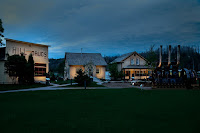by Roseann Davidson
Executive Director, Heritage Village and Heritage Shipyard
Natural disasters hit our city and our museums not
once, but twice. This is our story.
The Hangingstone River Flood of June 2013 devastated Heritage Village (formerly Heritage Park) and we wondered how we would ever function as a museum again. The damage to our buildings, infrastructure, collections, and archives was beyond our comprehension.
Yet four years later, through the tireless work of our staff, Board of Directors, volunteers, and external partners, we began a new chapter. Our new beginning placed us in a position to become bigger and better than we could ever have imagined. We affectionately grew to call this time as our “flood of opportunity.”
 |
| The Hangingstone
River Flood leaves Heritage Village (then Heritage Park) under water. All images courtesy of Roseann Davidson |
During this period of rebuild and restoration, we faced what we felt were unsurmountable challenges. Ten days after the waters receded, we were allowed back into the site, and what we discovered was complete devastation. Our staff and volunteers’ physical and emotional safety were our primary concerns. Precautions were taken to protect them from debris, mud, mold, and, as much as possible, burnout.
 |
| The landscape and
buildings sustain the worst damage. Fourteen of seventeen buildings sustain significant damage |
Most of our historical buildings, our large
outdoor artifacts, and collections were covered in mud and debris; mold was
setting in. As we assessed the situation, we soon discovered we had to move as
much of the collection as possible off our site.
Acquiring proper storage for our
collections and archives was particularly difficult as storage was in high
demand at this time, and finding the climate controlled conditions that our
collection required was next to impossible. Staff worked laborious days
assessing our collections for damages, isolating mold infested objects, and
cleaning objects with the help of community volunteers.

The local community – including landscaping companies, local forestry rangers, and individual volunteers – offers support.
Because the Village is located in a flood zone,
our insurance would not cover the costs to rebuild. We were then challenged with
procuring funds to cover what would become a $14 million project. Another of
the challenges we faced was finding qualified contractors with knowledge in
heritage conservation and preservation.
Emergency work is needed to remove mold and stabilize the historical buildings. The Chateau Gai (Grey Nuns exhibit), which sustained significant damage, is pictured here before and after being restored.
By 2016, both of our museums had undergone extensive renovations. Heritage Shipyard was due to open in May 2016, and Heritage Village was nearing the completion of the rebuild with new exhibits scheduled to be open later that summer. However, this was not meant to be, as another disaster was on the horizon.
The Wildfire
of May 2016 shattered our dreams of opening the museums to the public. The
devastation of this natural disaster took its toll on our community and greatly
affected our museum facilities, contractors, and staff.
Our biggest challenges this time was getting permission to return to our homes and our museums after our massive evacuation of 88,000 people from Fort McMurray. We were out of the community for one month. The contractors who had been working on the rebuild were not able to return for nearly two months and this setback cost us further delays in the opening of both sites.
We were very thankful that both museum sites sustained only minimal damage from the fire; however, we still had to deal with damages to our collections due the soot throughout the facilities. All of the collections and archives had to be sorted for damages and thoroughly cleaned. Our gift shops’ merchandise had to be inspected, sorted, and damages removed and reported to our insurance company. Once again, staff worked countless hours.
You can imagine our delight when we were finally able to open the Heritage Shipyard in July, and Heritage Village in August, 2017. The museum sites, the ships, the buildings, the artifacts, the exhibits, and the visitor experience have been revitalized. The changes are both stunning and inspiring.
As part of our rebuilding efforts, we have rebranded ourselves as the Fort McMurray Heritage Society. Our two cultural destinations are now called Heritage Village and Heritage Shipyard. Our new names and graphic identities make our presence known and our relationship with the two venues easier to recognize in the community. It also reflects the improvements that have taken place in both destinations.
I would like to extend a heartfelt thank you to our museum network friends and to the Alberta Museums Association and staff for the outstanding support we received during these challenging times. Knowing that we were not alone on this journey was reassuring and motivating.
As we build resiliency within our organization, we are once again looking forward to our future. Fort McMurray is striving to attract visitors and shed its reputation as an unreachable, remote community. We are so much more than oil. Our community is rooted in the fur trade and was historically reached by train, barge, ship, dogsled, plane, and floatplane among other methods of transportation.
Some of this multifaceted history is depicted in the Fort McMurray International Airport: YMM’s wonderful observation area showcases the history of flight in our area. Next time you are flying in or out of Fort McMurray, visit the observation area to view what we are sharing with folks, and how they too can discover our rich heritage and explore our two destinations, Heritage Village and Heritage Shipyard.
















No comments:
Post a Comment